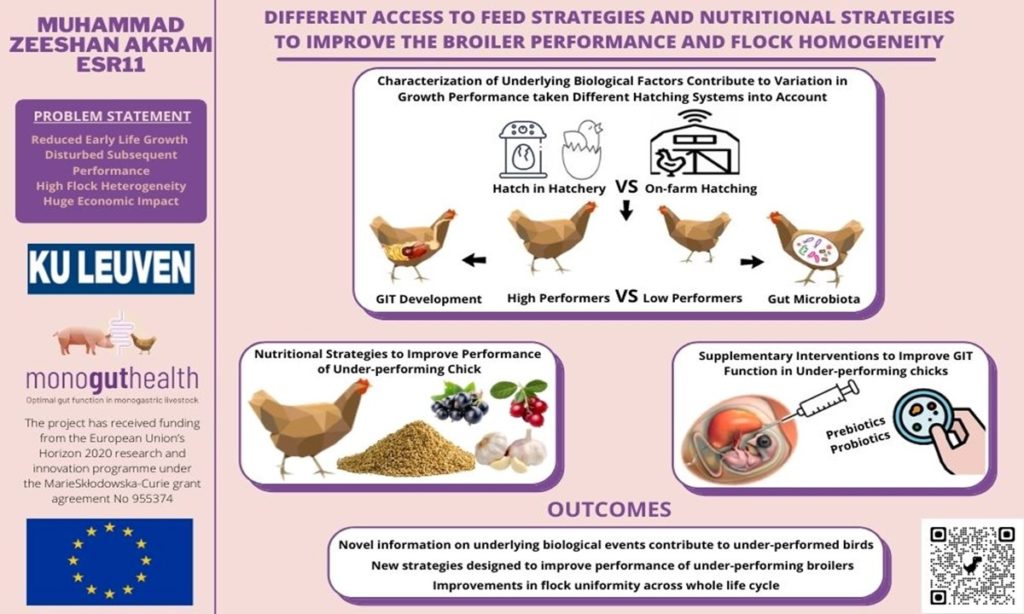ESR11: Different access-to-feed strategies and nutritional strategies to improve broiler performance and flock homogeneity
Background
BroilersChickens kept for meat production. Fast growing breeds can reach a weight of over 2 kg at 5 weeks of… traditionally hatch in a commercial hatchery and have delayed access to first feed, which may negatively affect intestinal development, immune response and performance. Besides access-to-feed, there are multiple reasons why certain animals underperform compared to their genetic potential, decreasing flock uniformity, which is a key performance indicator and economic driver in commercial practice.
We hypothesize that the determination of biological factors contributing towards variation in performance in the early life of birds will help to identify the prime cause behind the difference in body weight of low, average and high growers. Following this, different feed strategies and nutritional strategies and in ovo supplementation of pre- and/or probioticsLive microbial feed supplements, which beneficially affects the host animal by improving its intesti… will be investigated to influence the perinatalRelating to the time, immediately before and after birth. development of the digestive tract, the colonization of the microbiota, the maturation of the gastro-intestinal immune system, and growth performance of (underweight) broilersChickens kept for meat production. Fast growing breeds can reach a weight of over 2 kg at 5 weeks of… to minimize the flock heterogeneity.
Objectives
Characterise the underlying biological factors including GITThe part of the digestive system that consists of the stomach and intestines. development, nutrient utilisation and microbiota colonisation that contribute to variation in broilerChickens kept for meat production. Fast growing breeds can reach a weight of over 2 kg at 5 weeks of... growth performance in early life and influence lifetime performance taken different access-to-feed strategies into account.
Develop nutritional strategies to improve earlylife performance and health in underweight chicks and reduce variation in broilerChickens kept for meat production. Fast growing breeds can reach a weight of over 2 kg at 5 weeks of... flocks.
Develop supplementary interventions using pre- and/or probioticsLive microbial feed supplements, which beneficially affects the host animal by improving its intesti... (in ovo injection in collaboration with PBS) to improve enteric microbial colonisation in underweight chicks to improve GITThe part of the digestive system that consists of the stomach and intestines. function and immunity and reduce flock variation.
Methods
Performance (body weight, feed intake, and growth), and the variation in birth weight and biological factors related to gut health will be monitored in a flock up to slaughter age (d 42) of chicks that hatched from different access-to-feed systems (hatchery, hatch-on-farm, brooder system) .
Based on findings related to GIT function and composition of selected microbial taxa from low, average, and high body weight, broilersChickens kept for meat production. Fast growing breeds can reach a weight of over 2 kg at 5 weeks of..., one nutritional intervention and one pro-/prebiotic in ovo strategy will be tested to improve homogeneity of the flock.
Expected results
Novel information on the underlying biological events which contribute to underweight, suboptimal broilerChickens kept for meat production. Fast growing breeds can reach a weight of over 2 kg at 5 weeks of... chicks (D1.1, D2.13) .
New strategies specifically designed to address dietary and immunological deficits in underweight broilersChickens kept for meat production. Fast growing breeds can reach a weight of over 2 kg at 5 weeks of... (D1.9).
Improvements in flock uniformity across whole life cycle (D2.3).
Planned secondments
- At: Vanden Avenne (1 mo); Training in feed formulation and technical aspects of broiler rearing;
- At: ULiege (1 mo); Training and analysis of gene expression of samples of the animal experiment by high throughput PCR
- At: Vencomatic (1 mo); Technical training on housing systems and equipment for broilers and laying hens developed by Vencomatic;
- At: PBS (3 mo); Training in in vitro screening of bioactives.
Enrolment in Doctoral degree:
ESR11 will be enrolled at KU Leuven and University of Liège, Gembloux Agro-Bio Tech
Supervisors
Nadia Everaert (KU Leuven), Katarzyna Stadnicka (PBS)
